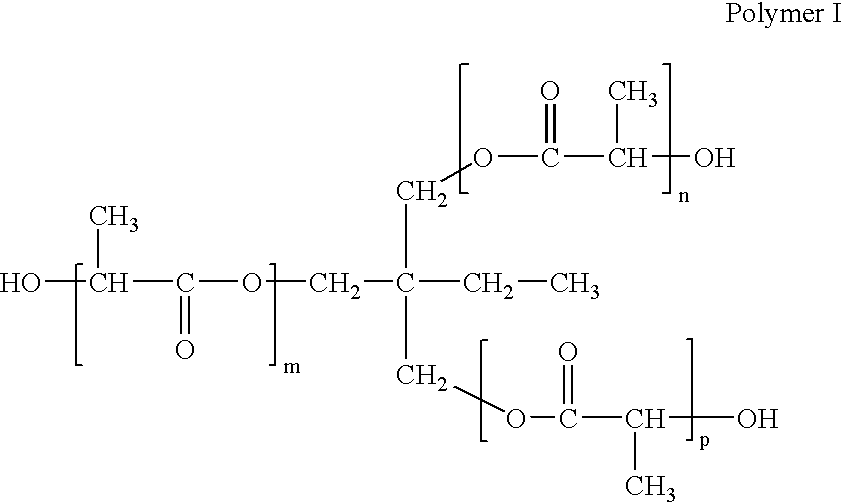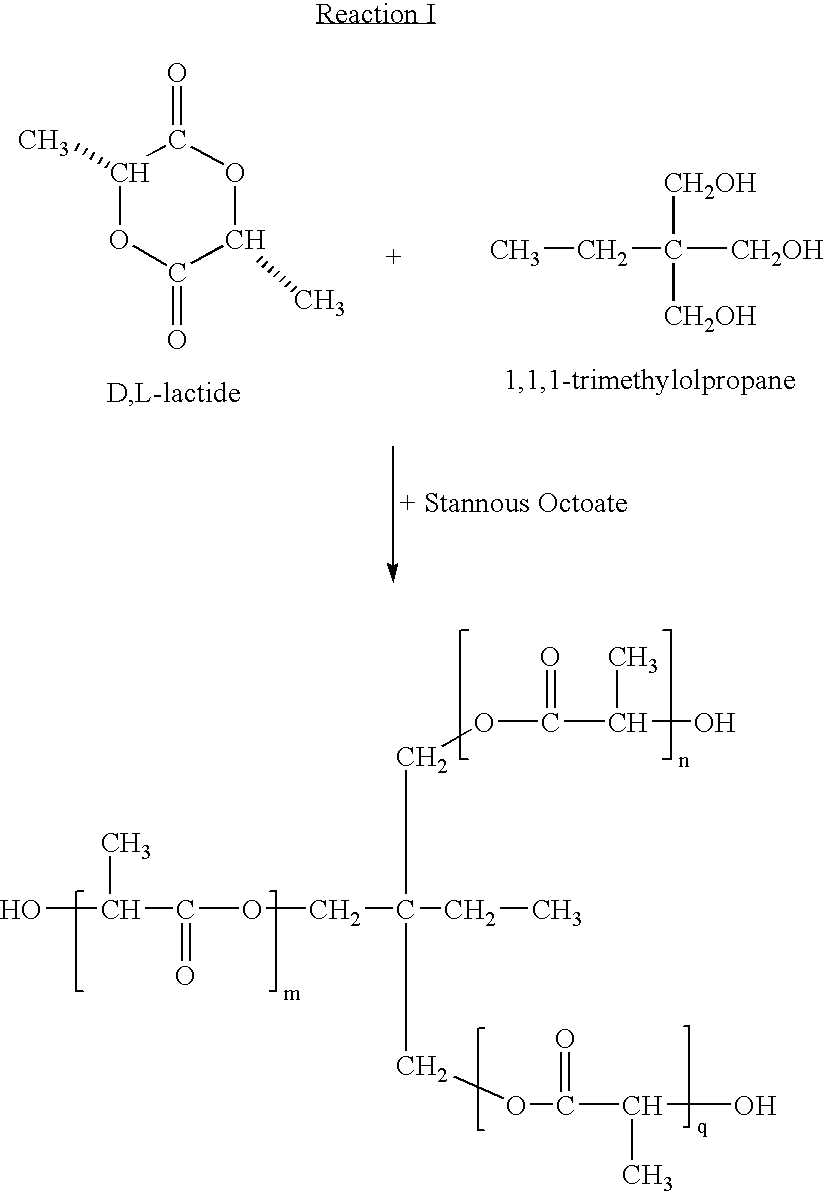Implantable devices comprising biologically absorbable star polymers and methods for fabricating the same
a star polymer and implantable technology, applied in the direction of prosthesis, surgery, blood vessels, etc., can solve the problems of occlusion of the conduit, adverse or toxic side effects of the patient, and intimal flaps or torn arterial linings
- Summary
- Abstract
- Description
- Claims
- Application Information
AI Technical Summary
Problems solved by technology
Method used
Image
Examples
example 1
Making the Polymer (A) as Shown be Reaction I Above
[0112] To a 500 ml flask equipped with magnetic stirrer, oil bath, distillation column with receiver, vacuum line, and argon inlet is added 125 ml of dry toluene, D,L-lactide (125 gm, 0.868 mole), and trimethylolpropane (0.2 gm, 0.0015 mole). Under reduced pressure and with stirring, the toluene is distilled off at 80° C. to remove water. After purging with argon, another 125 ml portion of dry toluene is added and the process repeated. A final 125 ml of dry toluene is added with stannous octoate (0.608 gm, 0.0015 mole) and the reaction mixture heated with stirring to 90° C. for 14 hours. After cooling to ambient temperature, the reaction mixture is slowly poured into 2 liters of cold methanol with gentle stirring. The polymer is isolated by filtration and dried under vacuum at 40° C.
example 2
Making the Polymer (B) as Shown be Reaction II Above
[0113] To a 500 ml flask equipped with magnetic stirrer, oil bath, distillation column with receiver, vacuum line, and argon inlet is added 125 ml of dry toluene, D,L-lactide (125 gm, 0.868 mole), and pentaerythritol (0.2 gm, 0.0015 mole). Under reduced pressure and with stirring, the toluene is distilled off at 80° C. to remove water. After purging with argon, another 125 ml portion of dry toluene is added and the process repeated. A final 125 ml of dry toluene is added with stannous octoate (0.608 gm, 0.0015 mole) and the reaction mixture heated with stirring to 90° C. for 14 hours. After cooling to ambient temperature, the reaction mixture is slowly poured into 2 liters of cold methanol with gentle stirring. The polymer is isolated by filtration and dried under vacuum at 40° C.
example 3
Making the Polymer (C) as Shown for Reaction III Above
[0114] To a 250 ml 3-necked flask equipped with magnetic stirrer, vacuum line, argon inlet, and oil bath is added 125 ml of dry toluene, n-butyl methacrylate (25 gm, 0.176 mole), 1,3,5-tris-cyclohexanoyl-2-bromo-isobutyrate (0.112 gm, 3.35×10−4 mole) and 2,2′-bipyridine (0.105 gm, 6.7×10−4 mole,). After dissolution by stirring, the reaction mixture is subjected to three freeze thaw cycles using a liquid nitrogen bath while pulling vacuum. After a final purge with argon, cuprous bromide (0.048 gm, 3.35×10−4 mole) is added and the temperature slowly raised to 90° C. After stirring for 24 hours, the solution is cooled and the polymer precipitated into 1 liter of methanol. After isolation by filtration, the polymer is dried under vacuum at 40° C.
PUM
| Property | Measurement | Unit |
|---|---|---|
| Fraction | aaaaa | aaaaa |
| Fraction | aaaaa | aaaaa |
| Length | aaaaa | aaaaa |
Abstract
Description
Claims
Application Information
 Login to View More
Login to View More - R&D
- Intellectual Property
- Life Sciences
- Materials
- Tech Scout
- Unparalleled Data Quality
- Higher Quality Content
- 60% Fewer Hallucinations
Browse by: Latest US Patents, China's latest patents, Technical Efficacy Thesaurus, Application Domain, Technology Topic, Popular Technical Reports.
© 2025 PatSnap. All rights reserved.Legal|Privacy policy|Modern Slavery Act Transparency Statement|Sitemap|About US| Contact US: help@patsnap.com



